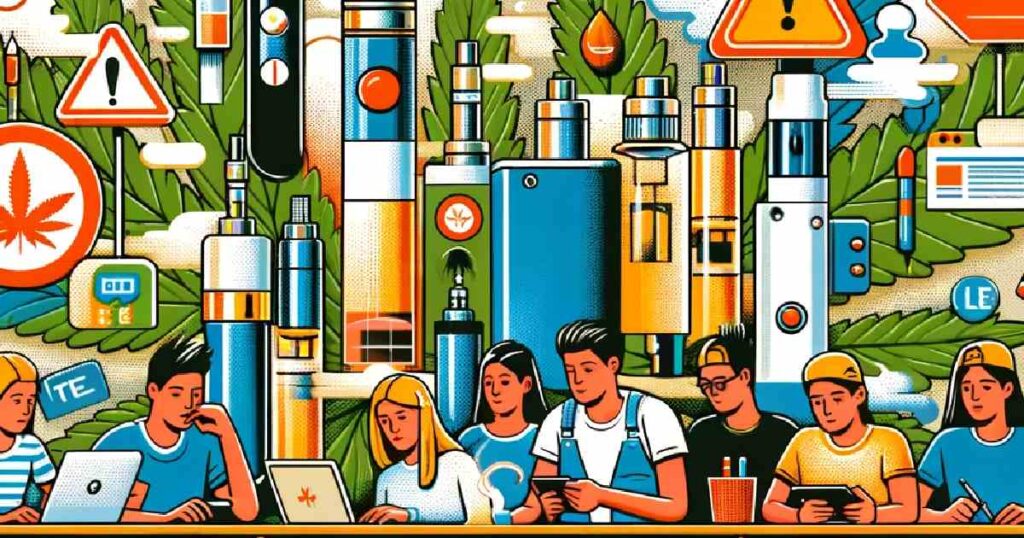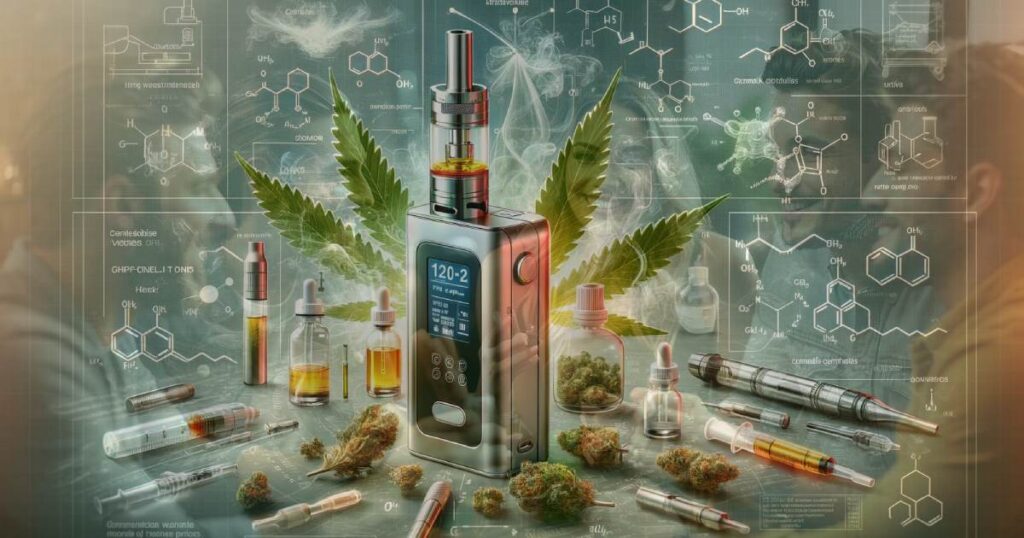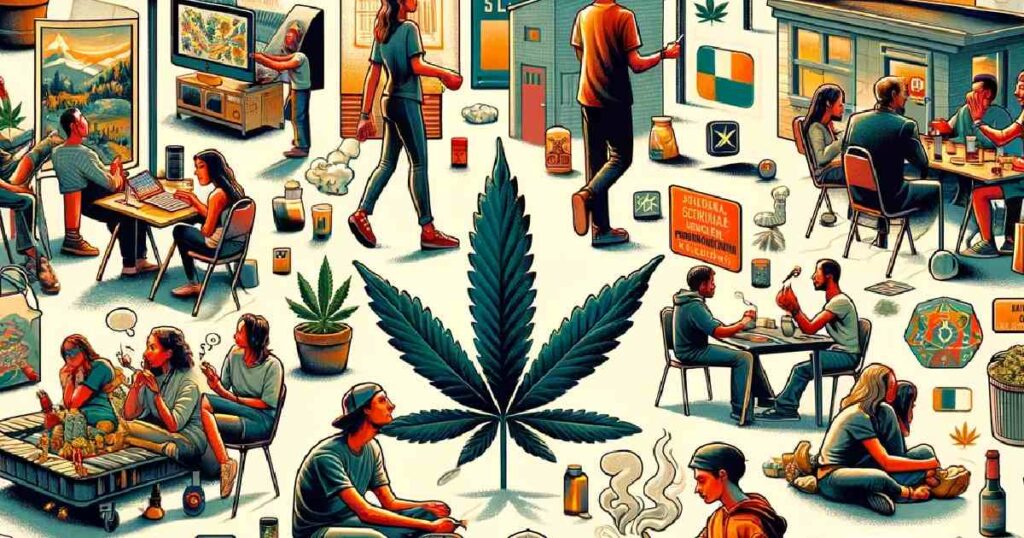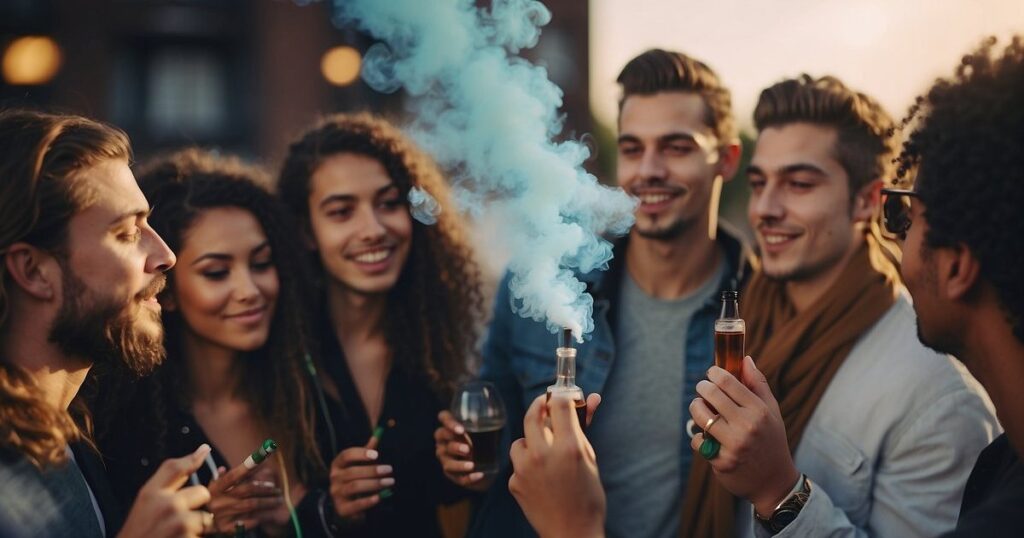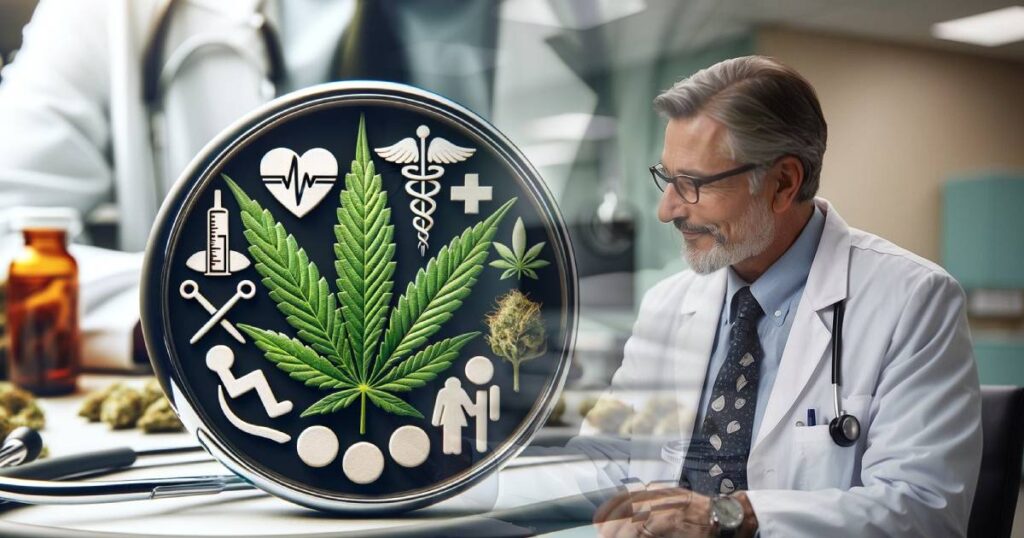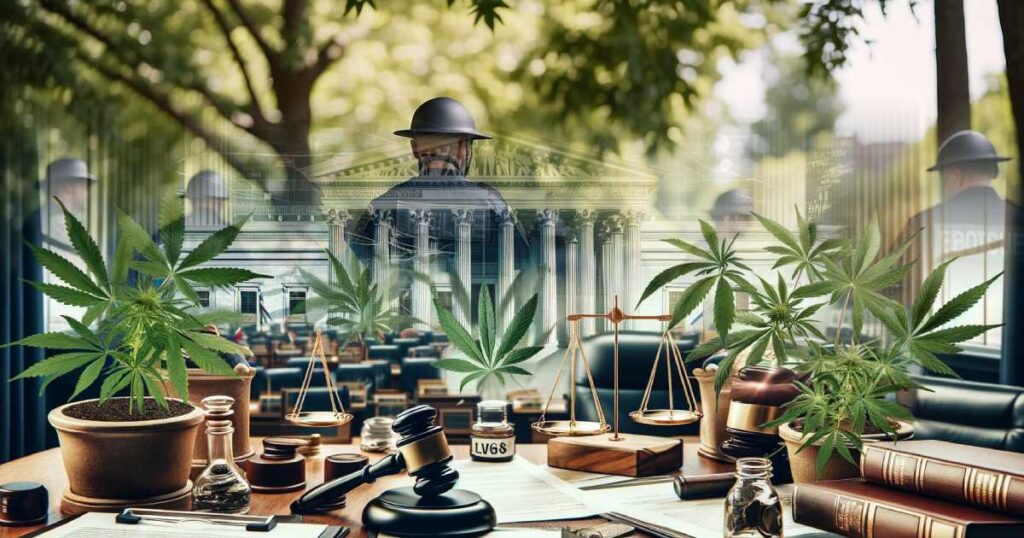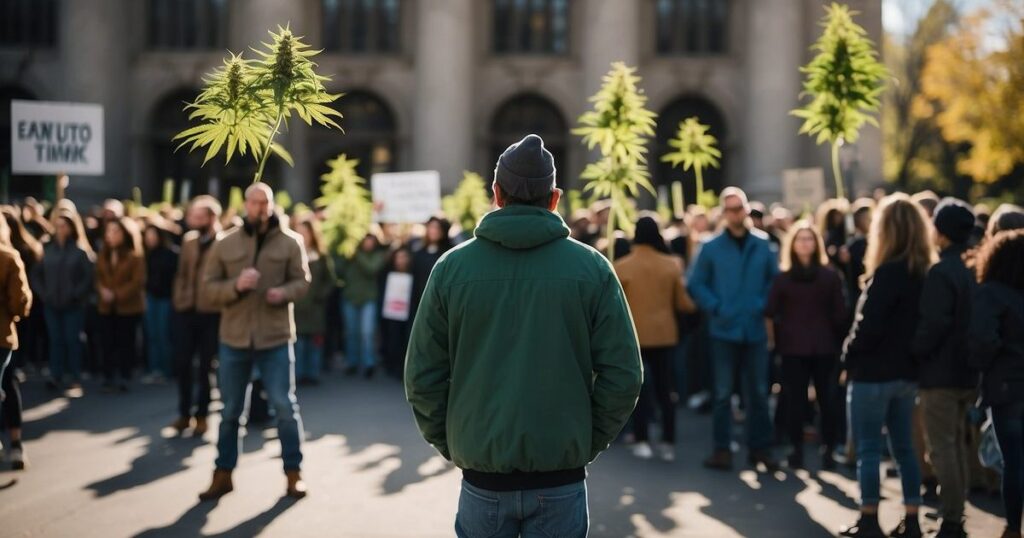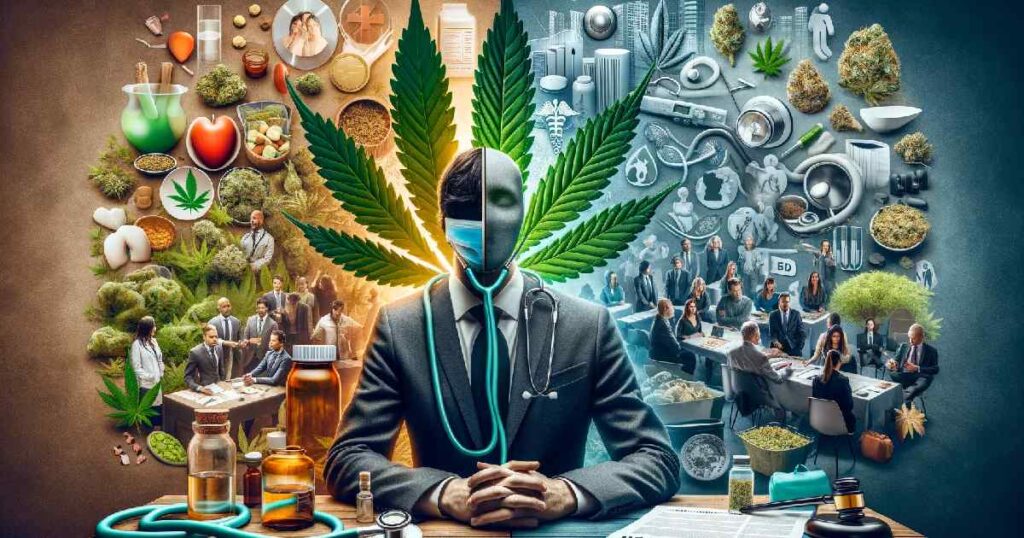Cannabis Vape in the Workplace: Navigating Legal and Policy Issues
Cannabis Vape in the Workplace: Navigating Legal and Policy Issues
The integration of cannabis into society has brought many changes, notably in the workplace, where employers and employees must navigate this new reality. With the rise of vaping as a popular method of consumption, cannabis vaping in the workplace emerges as a significant topic of discussion. As an employee or employer, you should be aware of the regulations and policies that govern the use of such substances on the job. The matter is legal and pertains to workplace safety, productivity, and culture.
Understanding your rights and the company policies is a prerequisite as the legal landscape around cannabis continues to evolve. While some states have legalized cannabis, it remains illegal under federal law, leading to potential conflicts in workplace policy enforcement. The use of cannabis vape at work can lead to questions about impairment, productivity, and the impact on overall workplace dynamics.
Key Takeaways
- Cannabis vape use in the workplace is subject to state and federal laws, as well as individual company policies.
- Employers must balance legal compliance with maintaining a safe and productive work environment.
- Employees should familiarize themselves with their rights and their employer’s policies regarding cannabis consumption.
Regulatory Landscape and Employer Considerations
Navigating the evolving regulatory landscape of cannabis vape use, such as Ypsilos products, is crucial for maintaining compliance and ensuring workplace safety. As an employer, your policies must adapt to the diverse state statutes while respecting federal guidelines.
State Laws and Federal Stance
State laws regarding cannabis use have varied greatly, with many states, including California, Colorado, and New York, legalizing marijuana for medical or recreational use. States such as Nevada, Arizona, and Illinois have specific laws protecting employees’ off-duty cannabis use. However, under federal law, cannabis continues to be classified as a Schedule I substance. This federal classification creates complexities for employers in balancing compliance with state and federal regulations.
Developing Workplace Cannabis Policies
Your workplace cannabis policies should reflect an understanding of state and federal laws. Ensure that you write policies to manage employees’ use of cannabis, especially vaping on the job, which may impair performance. Consider the legalities and restrictions of drug testing in your state when implementing drug testing policies.
Addressing Safety, Health, and Impairment
Workplace safety is paramount. You must address safety concerns associated with cannabis impairment that may increase the risk of accidents and injuries. The National Institute for Occupational Safety and Health (NIOSH) provides resources to evaluate health hazards and maintain worker safety. It’s critical to understand how THC, the psychoactive component of cannabis vape, might impair motor functions and cognition.
Legal Implications and Protections
It’s essential to consider the legal implications of disciplining or terminating employees based on cannabis use. Anti-discrimination laws in some states protect medical cannabis users, and certain states prohibit employers from penalizing employees for legal off-duty conduct. Stay informed on the protections in the jurisdictions where you operate to avoid potential liability.
Impacts on Workplace Dynamics and Culture
Cannabis use in the workplace, mainly vaping, can significantly affect multiple aspects of the work environment, from productivity and performance to overall safety and health conditions.
Influences on Productivity and Performance
Cannabis vaping can influence your productivity and performance at work. Cannabis, mainly containing THC, can cause impairment, leading to a high state that may hinder your cognitive functions and physical coordination. This impairment can compromise your ability to accomplish tasks effectively and safely. Moreover, the effects on productivity can be broader, potentially leading to increased absenteeism and reduced overall workplace output.
Ensuring a Safe and Healthy Work Environment
Maintaining a safe and healthy workplace is paramount, including managing air quality. Cannabis vape aerosols can introduce particulate matter into indoor air, potentially affecting not just the user but also other employees’ workplace health. Employers must address these factors within their occupational safety and health protocols and align with standards set by organizations like OSHA and NIOSH to prevent health hazards.
Adapting to Changing Attitudes and Demographics
Demographic shifts and evolving attitudes toward cannabis legalization have implications for workplace culture. You may witness a growing acceptance of medical and recreational cannabis use, influencing organizational policies. Companies must calibrate their drug testing practices and resources to balance respect for legitimate medical cannabis use against enforcing a drug-free work setting.
Technological and Methodological Developments
Technological advancements offer new methods for detecting impairment and ensuring workplace safety. Developments in drug testing can help your employer determine recent use, though distinguishing impairment levels remains complex. Employers might also utilize technology to provide training and resources to educate you on the impact of cannabis vaping on your well-being and workplace performance.
Frequently Asked Questions
In the evolving landscape of cannabis legality, your concerns about cannabis vape in the workplace touch on important issues such as employment policies, productivity, and your rights as a worker.
Can an employee be terminated for using a cannabis vape while on the job?
Yes, the company can terminate you for using a cannabis vape. At the same time, on the job, most employers maintain drug-free workplace policies that prohibit the use of intoxicants during work hours, including cannabis, regardless of its legal status.
Is it considered gross misconduct to vape cannabis in the workplace?
Vaping cannabis in the workplace can be considered gross misconduct. Companies have the right to enforce strict no-drug policies, and any violation can lead to serious disciplinary actions, including termination.
Are there any legal protections for using CBD oil at work?
State and local laws vary in their provision of legal protections for using CBD oil at work. Doctors sometimes prescribe CBD oil for a medical condition, making it permissible. Still, you should consult your company’s policy and your state’s regulations to understand your legal standing.
How long can CBD be detected in an individual’s system?
Generally, an individual’s system can detect CBD for two to five days. However, this can vary depending on several factors, such as the quantity used, frequency of use, and the individual’s metabolism.
Will using CBD products affect the status of federal employees?
Federal laws hold federal employees accountable for the illegality of cannabis and its derivatives, such as CBD. Usage of CBD products can affect your status as a federal employee and may lead to disciplinary action or termination.
Can the odor of cannabis vaping be detected in the workplace environment?
In the workplace environment, people can detect the odor of cannabis vaping. This can raise concerns among co-workers and employers, potentially leading to disciplinary measures if they violate workplace policy.
Stigma Around Cannabis Vape: Dispelling Myths and Understanding Facts
Stigma Around Cannabis Vape: Dispelling Myths and Understanding Facts
Vaping cannabis has become one of the many methods individuals use to consume marijuana, yet it carries a unique stigma within society. Despite the increasing adoption of cannabis for both medical and recreational use, people often perceive vaping differently from other methods of consumption. This distinction is partly due to concerns about the health implications of vaping and the portrayal of vaping devices in the media. Additionally, the act of vaping cannabis is sometimes associated with negative stereotypes that may impact users’ willingness to disclose their consumption habits. Efforts to address this stigma are multifaceted, involving education on vaping as a consumption method and the medicinal benefits of cannabis where applicable.
Healthcare providers and legislators play a crucial role in shaping the public’s perception of cannabis vaping. As more states and countries legalize the medical and recreational use of cannabis, an evolving framework of laws reflects changing attitudes. However, there remains a tension between recognizing the therapeutic potential of cannabis and combating ingrained societal biases. Education and open dialogue, facilitated by both the healthcare industry and legal systems, are essential in deconstructing the myths around cannabis use and its various forms, including vaping.
Key Takeaways
- Cannabis vaping is viewed differently within society, influencing users’ openness about their consumption habits.
- Legislation and healthcare education are crucial in reshaping the perception of cannabis vaping.
- Addressing stigmas surrounding cannabis vaping involves education on its health implications and benefits.
Understanding Cannabis Stigma and Its Impact
Cannabis stigma has significantly evolved, yet various forms persist, influencing both individual and societal perspectives.
Historical Context and Societal Attitudes
Historically, propaganda, legal repercussions, and social disapproval stigmatized cannabis use. Enacted stigma often resulted in discrimination and rejection. Despite changes in law and medical use recognition, negative attitudes persist, predominantly questioning the responsibility of use and its compatibility with societal norms.
Types of Stigma Associated With Cannabis Use
With cannabis vapes, you may encounter social stigma—where society views use as a deviant behavior—and internalized stigma, where you may adopt society’s negative attitudes. Furthermore, feeling stigma may cause you to fear judgment, while enacted stigma can lead to discrimination. Types of stigma include:
- Health-related stigma: For those using cannabis vapes to manage chronic pain or mental health, the stigma may conflict with their quality of life improvements.
- Social stigma: Employers, institutions, and even family members may hold biases against vaping cannabis despite its legalization and medical benefits.
Consequences of Stigma on Individuals and Society
Stigma can lead to adverse mental health outcomes and a lower quality of life as you may internalize society’s condemnation. It also poses a barrier to cannabis acceptance as a therapeutic tool. Moreover, discrimination and stigma can deter your honest discussions with healthcare providers, influencing your treatment options for conditions like chronic pain.
Navigating the Terrain: Medical Use, Legalization, and Public Perception
As you explore the arena of cannabis vape, such as Ypsilos products, it’s essential to understand the dynamics between medical cannabis usage, the evolving legal landscape, and the shifting tides of public opinion that influence stigma.
Medical Cannabis: Perception and Professional Approaches
Medical cannabis, encompassing both THC and CBD, is recognized for its therapeutic potential. Healthcare providers are increasingly open to medicinal cannabis as a treatment for various conditions, which has led to an expansion in medical marijuana policies across states. As a patient, the acceptance of cannabis by professionals plays a crucial role in diminishing stigmas and may lead to more personalized and supportive care.
Legal Landscape and Its Influence on Stigma
Legislation on cannabis has a significant impact on public stigma. With the advent of medical and recreational legalization in numerous states, the narrative surrounding cannabis use is gradually shifting. Policies that distinguish between medical use and illicit drug use foster a nuanced understanding that cannabis, particularly in vape form, can serve legitimate medicinal purposes.
| Legal Status | Stigma Impact |
| Prohibition | Increases negative perceptions |
| Medical Legalization | Reduces stigma for patients |
| Full Legalization | Potentially normalizes use |
Changing Public Opinion and Media Representation
Changes in legislation and media portrayals of cannabis sway public opinion. A broader representation of patients benefitting from its therapeutic effects is challenging stereotypes that once defined cannabis users. As societal norms evolve, you can observe a significant shift in the narrative, with a more neutral and fact-based approach to discussing both the benefits and considerations of cannabis vape.
Remember, while perceptions are transforming, the journey to eliminate the stigma around cannabis vape use is an ongoing process.
Frequently Asked Questions
This section addresses some common queries you might have regarding the misconceptions and societal views that surround the stigma associated with vaping cannabis.
What are the common misconceptions about vaping cannabis that contribute to its stigma?
Misconceptions about vaping cannabis stem from a lack of understanding of its effects. For instance, some believe that all vaporizers containing THC have the potential to cause harm or lead to other substance abuse, disregarding the variations in individual responses and potential medicinal benefits for conditions like anxiety, depression, and PTSD.
How has the historical portrayal of cannabis affected the contemporary views on cannabis vaping?
Historically, society has portrayed cannabis as a dangerous and addictive substance. This legacy still influences contemporary views on cannabis vaping, making it challenging to separate the act from the negative stereotypes and acknowledge its potential therapeutic uses.
What are the societal impacts of stigmatizing cannabis vape users?
Stigmatizing cannabis vape users can lead to social alienation and deter individuals from accessing it for legitimate medicinal purposes. It may also contribute to a culture of misinformation that hinders a balanced public discourse on safe consumption and regulation.
How do legal regulations influence public perception of cannabis vaping?
Legal regulations, or the lack thereof, greatly influence public perception. In regions where cannabis is illegal, or vaping is regulated, there can be an assumption that these activities are inherently harmful or morally wrong, even when done responsibly.
What role does scientific research play in addressing the stigma around vaping cannabis?
Scientific research provides evidence-based insights into the effects of vaping cannabis, helping to dispel myths and inform public opinion and policy. Addressing fears with facts and shifting the narrative towards an understanding based on clinical evidence is crucial.
In what ways can education improve the public understanding of cannabis vape use?
Education can demystify the process and effects of vaping cannabis, explaining its differences from other forms of consumption and potential medicinal benefits. Increased awareness and understanding may lead to reduced stigma and more informed opinions.
Cannabis Vape and Social Media: Navigating the Digital Landscape
Cannabis Vape and Social Media: Navigating the Digital Landscape
As the landscape of social media intersects with various lifestyle choices, one particular trend has captured the attention of public health officials: the rising use of cannabis vaping among youth and young adults. You may have noticed that cannabis vaping content is increasing across social media platforms, reflecting not just a shift in consumption habits but also the nuanced ways in which people are marketing and sharing these practices online. It’s essential to recognize how this digital environment is playing a role in shaping perceptions and potentially influencing behaviors related to cannabis vaping.
Furthermore, vaping cannabis has become a discreet and accessible method for consumption, especially for youth. With its expansive reach, social media acts as a catalyst, facilitating discussions and spreading information—or misinformation—about this consumption method. As a user, your exposure to vaping-related content can vary from educational to promotional. Moreover, brands like Ypsilos and influencers on social media platforms often employ sophisticated marketing strategies, creating appealing content that may downplay the risks or promote the use of cannabis vapes, making it crucial for you to discern the intent behind these messages.
Key Takeaways
- Cannabis vaping is increasingly prevalent among youth, influenced by content on social media platforms.
- Social media serves as a key medium for the marketing and promotion of cannabis vaping.
- As a consumer, you are encouraged to evaluate vaping-related content online critically.
Cannabis Vape Use Among Youth and Young Adults
In this section, you will discover the significant trends and concerns associated with cannabis vaping among youth and young adults, including usage patterns, health risks, and the evident impact of social media on this phenomenon.
Prevalence and Patterns of Use
Recent studies have shown an increase in cannabis vaping among adolescents in the USA and Canada, with reported usage rates showing substantial rises over the past decade. Additionally, the prevalence of cannabis vaping spans from occasional use to frequent, with high school seniors demonstrating a notable frequency.
Health Implications and Risks
Cannabis vaping poses potential health risks, such as respiratory symptoms, addiction, and, in some cases, severe lung injury known as EVALI. In addition, your understanding of these risks is vital, especially considering the high THC content found in some cannabis e-liquids and concentrates, which may lead to increased tolerance and intoxication levels.
Sociodemographic Factors and Settings
Note that various demographic groups engage in cannabis vaping, but factors such as sex, race/ethnicity, and settings where vaping occurs (such as at home or with friends) influence it.
Influences of Social Media
Social media plays a pivotal role in the promotion and normalization of cannabis vaping. Further, platforms like Instagram and Twitter feature content from influencers that may impact your decision to initiate or continue vaping.
Regulatory Aspects and Prevention Efforts
Regulations and prevention efforts from organizations like the U.S. Food and Drug Administration (FDA) and the Center for Tobacco Products aim to curb adolescent nicotine and cannabis use. Furthermore, age restrictions and crackdowns on e-cigarette marketing are key strategies.
Research on Epidemiology and Surveillance
Research by entities such as the National Institute on Drug Abuse provides surveillance on trends and risk factors for youth vaping, which can inform your knowledge of the epidemiology of cannabis vape use.
Substantial Effects of COVID-19 on Vaping
The COVID-19 pandemic has influenced patterns of cannabis vaping among youth, with changes in availability and social settings possibly affecting your use and access to cannabis vaping products.
Marketing and Promotion of Cannabis Vaping Through Social Media
Social media has become a pivotal arena for the marketing and promotion of cannabis vaping products. This section dissects the dynamics of social media marketing, its impact on consumption, and the importance of education and awareness in counteracting promotional tactics.
Vape Marketing and Social Media Dynamics
Marketing strategies for cannabis vaporizers, such as Juul and other e-cigarette brands, often leverage social media platforms due to their vast reach, particularly amongst adolescents and young adults. Additionally, researchers have linked increased electronic cigarette use with social media use. Also, the tactics used include engaging content, influencer partnerships, and communities that tend to mirror social contexts where substance use, including alcohol and tobacco product use, is normalized.
- Community Engagement: Brands build loyal online communities to foster product curiosity and usage.
- Influencer Marketing: Popular figures on platforms like Instagram and Facebook are often employed to promote vaping products subtly.
- Content Sharing: Shareable content enables rapid dissemination of promotional material within networks.
Impact of Social Media on Cannabis Vape Consumption
Your exposure to cannabis vaping content on social media can correlate with the initiation of cannabis vaping. In addition, studies have shown a relationship between social media marketing and increased vaporizer use among youth and young adults, indicating how powerful such advertising can be in influencing substance use behaviors, often normalizing illicit substances along with legal ones like alcohol and traditional tobacco products.
- Exposure-Consequence Link: More frequent social media exposure increases the likelihood of trying e-cigarettes.
- Peer Influence: Seeing peers engage with vaporizer brands on social media can impact an individual’s decision to start vaping.
Countering Online Promotion with Education and Awareness
Education and awareness campaigns are critical in counter-messaging the aggressive promotion of e-cigarettes and cannabis vaping on social platforms. Hence, these campaigns aim to inform you about the potential risks of vaping and present a counter-narrative to the often one-sided views presented by marketing content.
- Information Dissemination: Using the same platforms for sharing educational content and prevention efforts.
- Engagement Strategies: Develop interactive and appealing content to engage users, particularly the younger demographic.
- Critical Thinking Encouragement: Encouraging you to think critically about the marketing strategies employed by vaporizer brands.
By understanding how to navigate the complex landscape of social media and its intersection with cannabis vape marketing, you can be more informed about the potential influences on your own or others’ e-cigarette use and make better choices regarding substance use.
Frequently Asked Questions
In this section, you’ll find targeted information addressing common inquiries about the intersection of social media and cannabis vaping among youth.
How does social media influence the perception of cannabis vaping?
Social media platforms often portray cannabis vaping as a normative behavior through content and testimonials, thereby influencing your perception. Marketing strategies featuring influencers can also skew your view, making vaping seem more acceptable and safe.
What are the trends in cannabis vape use among adolescents as seen on social media platforms?
Recent trends show an uptick in cannabis vaping content on social media, with adolescents particularly exposed to posts that glamorize its use. Also,documented increases in vaping among teens correlate with the visibility and engagement such content receives online.
What physical signs should parents look for if they suspect their teen is vaping cannabis?
Look for signs such as chronic cough, throat irritation, increased thirst, and unusual odors on your teen’s clothing. Also, physical evidence might include vape pens or cartridges that are often discreet and easily concealed.
What are the short-term effects of vaping cannabis that users often discuss on social media?
Users on social media frequently discuss short-term effects like relaxation and euphoria. Still, they may also mention experiencing dry mouth, red eyes, impaired short-term memory, and altered time perception.
How do discussions on social media compare the health impacts of dry herb vaporizers and other vaping methods?
Discussions claim that dry herb vaporizers are a ‘cleaner’ method due to the absence of potentially harmful additives in some vape oils. However, the comparisons often need more than the full scientific context, presenting more anecdotal evidence than research-based data.
Are there any reported symptoms or signs shared on social media that indicate someone is high from vaping cannabis?
Users often report and share symptoms such as heightened sensory perception, altered physical coordination, increased appetite, and changes in mood or behavior as indicators of being high from vaping cannabis.
Social Norms and Cannabis Vape: Shifting Perceptions in Society
Social Norms and Cannabis Vape: Shifting Perceptions in Society
Cannabis vaping has emerged as a significant social phenomenon, particularly among youth and young adults. Unlike traditional smoking methods, vaping cannabis is done through electronic devices such as Ypsilos products, which heat the substance to release its active components without combustion. This practice has challenged conventional social norms, as the sleek design of vape devices and their perceived lower health risk compared to smoking have made cannabis use more discreet and, to some users, more socially acceptable.
The influence of social norms on cannabis vaping behavior cannot be understated. Vaping, in general, has developed its own culture and acceptance, which can vary widely between different demographics and regions. Perceptions of what is socially acceptable influence individual decisions to vape cannabis, with youths often being more susceptible to peer influence and social pressures. Shifting attitudes towards marijuana and the legalization movement in several jurisdictions further complicate the landscape, as they may inadvertently normalize cannabis vaping and affect teens’ and young adults’ perceptions of risk.
Key Takeaways
- Vaping cannabis is discreet compared to traditional methods and is changing social norms.
- The social acceptability of vaping varies by region and demographic, influencing individual usage.
- Legal shifts in cannabis policy play a significant role in societal attitudes towards vaping.
Understanding Cannabis Vape
When you consider cannabis vape, you’re looking at a contemporary method of consuming marijuana through devices known as vaporizers or electronic cigarettes. These devices heat cannabis oil or dried plant material to produce vapor rather than smoke. There are two main types: those designed specifically for cannabis products and those initially created for vaping nicotine.
Vaping cannabis has become an alternative to smoking cigarettes or using other forms of tobacco products due to its perceived reduced harm. However, the scientific community is still examining the long-term health implications of vaping. Ongoing research and emerging regulations should inform your understanding of its health profile.
- Dual users: These individuals use both nicotine and marijuana vaping products. Comparatively, dual users may begin vaping at an earlier age and do so more frequently, yet they might not use cannabis every day.
- Frequency: The amount and regularity of cannabis vape use can vary widely, often influenced by individual factors like dependence or social scenarios.
- Dependence: Unlike traditional smoking, vaping can create a distinct pattern of addiction, though studies are still assessing the full scope of dependence associated with cannabis vape.
- Regulation: Vaping products are subject to evolving laws affecting availability and public perception. Proponents argue that regulation can ensure safety and quality, while skeptics worry about accessibility and the rise of underage use.
Your awareness of cannabis vaping impacts societal attitudes and norms. It has shifted conversations about marijuana usage from clandestine to openly discussed topics, even challenging the negative stigma once associated with cannabis consumption. As you navigate the shifting landscape of cannabis vape, stay informed about its legal status, potential risks, and how it alters traditional views on marijuana use.
Social Norms and User Behavior
Understanding how social norms impact the behavior of individuals, particularly young adults, concerning cannabis vaping is crucial for addressing trends and influencing prevention efforts.
Influence of Social Norms on Cannabis Vape Use
You may find that the prevailing social norms influence your perceptions and attitudes towards cannabis vaping in your environment. As social acceptance of cannabis increases, you may perceive it to be a common and acceptable behavior, which can impact your decision to start or continue vaping cannabis. National surveillance and surveys by the National Institute on Drug Abuse (NIDA) suggest that when friends and peers use cannabis, it often leads to a normalization of these behaviors among young adults and college students.
Social Media and Cannabis Vaping Trends
Social media can significantly shape your exposure to cannabis vaping. Advertising and organic content on these platforms often portray cannabis vaping as trendy and appealing, impacting your attitudes and increasing your motivation to vape. Paying attention to these messages is essential, as they can subtly influence your perception of the normalcy and acceptability of vaping cannabis.
Prevention and Risk Factors
When considering prevention efforts, it is important to understand the risk factors associated with cannabis vaping. Youths and young adults may not fully take into account the potential for substance use problems or the co-use of other substances like tobacco and alcohol. Recognizing these risks and how social settings and contexts contribute to vaping behaviors could guide more effective prevention strategies.
Perceptions and Motivations for Vaping Cannabis
Your reasons for using cannabis vape can range from enjoyment and relaxation to flavor preferences and harm reduction when compared to traditional smoking. Surveys often utilize logistic regression to analyze these motivations about demographic characteristics. These motivations are crucial; understanding them can help tailor interventions to change perceptions and behaviors among different demographics.
Initiation and Usage Patterns Among Different Demographics
Observing patterns of initiation and usage among college students, youth, and young adults, you’ll notice variations based on demographic characteristics. Logistic regression analyses in surveys reveal that factors such as setting, social context, and parental attitudes substantially influence the initiation and frequency of vaping cannabis. Attention to these factors can aid in identifying at-risk groups and adjusting prevention efforts accordingly.
Frequently Asked Questions
This section addresses your inquiries regarding the shifting social perspectives and the acceptance of cannabis vaping in various environments.
How has the perception of vaping evolved in recent social contexts?
In recent years, you might have noticed a shift in public attitudes toward vaping, which has become more visible due to its portrayal as a less harmful alternative to traditional smoking. In regions where it’s legally sanctioned, society has shifted its view on vaping cannabis from a stigmatized behavior to a more tolerable one.
To what extent is vaping cannabis accepted in different social settings?
Your experience with the social acceptance of vaping cannabis can vary widely depending on geographic location, local laws, and cultural norms. In some areas, vaping cannabis is accepted mainly in social circles due to its legal status and perceived medicinal benefits. At the same time, it might still be considered taboo in other places.
What are the common social concerns associated with vaping among youths and young adults?
You may have concerns about the increase in vaping cannabis among youth, fueled by apprehensions about addiction, mental health implications, and the potential for it to act as a gateway to other substances. These concerns often influence societal efforts to regulate and monitor its use among younger populations.
How do demographic factors influence patterns of cannabis vaping?
Your demographic background, including age, economic status, and ethnicity, can significantly influence vaping patterns. Young adults in urban settings with liberal attitudes towards cannabis are often more prone to vape, highlighting the relationship between demographic variables and consumption behaviors.
Can the use of cannabis vape pens be linked to changes in social behavior and interactions?
Your use of cannabis vape pens can potentially alter social behavior and interactions, with anecdotal evidence suggesting both positive effects, like increased relaxation and sociability, and negative ones, such as social withdrawal or hindered communication in non-accepting social settings.
What impact does social media have on the public perception of vaping?
Your exposure to vaping on social media can play a significant role in shaping your perception of cannabis use. Trendy, glamorous portrayals of vaping devices often attract a younger demographic and may downplay health risks, influencing both social acceptance and concerns about its widespread use.
Public Opinion on Cannabis Vape: Perceptions and Trends in Usage
Public Opinion on Cannabis Vape: Perceptions and Trends in Usage
Cannabis vaping has rapidly evolved, leaving a notable footprint in the realm of public discourse. While your perception of cannabis vape may vary, the trend itself has garnered significant attention due to its increasing presence among youths and the broader public. Contrary to traditional methods of cannabis consumption, vaping has introduced a discreet and purportedly less harmful way to consume, such as Ypsilos products, which you may find alluring or concerning, depending on your standpoint on drug use and public health.
Furthermore, the public’s view on cannabis vaping hasn’t been static. You’ve witnessed shifts that correlate with rising health concerns, evolving regulations, and the spread of information regarding its effects. As the practice began intersecting with a younger demographic, the response has been multifaceted; it sparked dialogues surrounding health implications, spurred regulatory efforts to curtail youth access, and influenced opinions through ongoing research findings. As a member of the public, your concerns or endorsement of cannabis vaping may weave into these broader patterns, affecting legislation and societal norms.
Key Takeaways
- Cannabis vaping’s discreetness and perceived harm reduction play a role in the public interest.
- Research, public health concerns, and regulatory discussions influence evolving perceptions.
- The intersection of cannabis vaping with youth trends invokes diverse public reactions and policies.
Public Perception and Use Trends
Your understanding of public perception and use trends concerning cannabis vaping is pivotal in analyzing the societal and health implications.
Social Attitudes Toward Cannabis Vaping
In the U.S. and Canada, social attitudes towards cannabis vaping have become increasingly permissive over recent years. Moreover, national surveys reveal that the perception of cannabis as a low-risk activity has led to a notable increase in the acceptance of cannabis vaping. However, despite the growing normalization, there remains a significant portion of the population concerned about potential health risks associated with vaping cannabis products.
Usage Among Adolescents and Young Adults
Recent surveillance, such as the Monitoring the Future study, indicates troubling trends in cannabis vaping among adolescents and young adults. The frequency of use has risen sharply, with many adolescents perceiving it as a safer alternative to smoking tobacco or cannabis. This uptick in prevalence, particularly in the U.S., where recreational use is often legal, highlights the necessity for ongoing education and prevention efforts that target this age group.
Comparative Trends: Vaping vs. Other Substances
The comparative analysis between vaping cannabis and the use of other substances shows distinct patterns. While traditional tobacco smoking continues to decline nationally, cannabis vaping has seen a more than twofold increase among adults in recent years. Monitoring these trends is essential, and organizations like the National Institute on Drug Abuse continue to highlight the importance of differentiating use behaviors and the associated health outcomes between substances.
Health Impact and Regulatory Responses
Cannabis vaping has garnered significant attention due to its implications on public health and subsequent regulatory responses. Your understanding of these aspects is essential as they shape the current landscape of cannabis use.
Health Effects and Research Findings
Research indicates that cannabis vaping involves inhaling aerosolized cannabinoids such as THC (tetrahydrocannabinol) through vaping devices. While this method avoids the smoke associated with traditional marijuana use, it is not without risks. Notably, the incidence of EVALI (e-cigarette or vaping product use-associated lung injury) highlighted potential health effects. The CDC’s investigations suggest that vitamin E acetate, often used as a thickening agent in THC-containing vaping oil, may be linked to EVALI.
- Public Health Concerns:
- Inhalation of potentially harmful substances
- Increased nicotine use among young adults
- Risks associated with cannabis vaping, especially among inexperienced users
Research is ongoing to determine the safety of e-cigarettes and cannabis-related vaping devices. Researchers are still evaluating the long-term health effects of vaping nicotine and cannabinoids, and individuals must stay informed of new findings.
Policy and Regulation
The policies and regulations at federal, state, and local levels shape your rights and responsibilities regarding cannabis use. Though the federal government maintains cannabis as a Schedule I substance, many states, including California, have legalized cannabis for medical or recreational use, thereby affecting tobacco use patterns and public opinion.
- Regulation Efforts:
- Bans on certain flavors and types of vaping products
- Age restrictions to curb youth access to e-cigarettes
- Public health campaigns to educate about the risks of vaping
The role of regulation is to protect public health while considering the legalization trends and their effects on society. Agencies like the CDC and local public health organizations aim to balance the safety concerns with the rights of individuals, responding to the evolving body of research and the shifting public opinion on cannabis vaping.
Frequently Asked Questions
In navigating the topic of cannabis vaping, your understanding of public opinion is crucial. This section addresses your most pressing questions with accurate, current perspectives.
What are the primary reasons people support the legalization of cannabis vaping?
You’ll find that supporters often cite the potential medicinal benefits of cannabis, the ability to regulate and ensure product safety, and the importance of personal freedom in choosing their method of consumption.
How has public opinion on cannabis vaping changed over recent years?
Your awareness of trends is important. Recent data suggests that adults are increasingly accepting cannabis vaping, paralleled by a rise in usage, especially in jurisdictions where it is legalized.
What concerns do individuals have about the health effects of cannabis vaping?
You might be interested to know that many individuals express concern regarding the potential respiratory effects of vaping, the presence of harmful additives, and the long-term consequences that are not yet fully understood.
In what ways do conservative views on cannabis vaping differ from liberal views?
Conservative perspectives often emphasize the need for regulation and concern over misuse, while liberal views may focus more on personal autonomy and the decriminalization aspects of cannabis use.
Are there any notable differences in cannabis vape acceptance among various age demographics?
Yes, generational divides exist, with younger age demographics typically showing higher levels of acceptance and usage compared to older individuals who may be more hesitant or opposed to cannabis vaping.
What are the arguments for and against the use of cannabis vapes compared to traditional smoking methods?
You’ll hear arguments referencing the discrete nature, reduced odor, and perceived harm reduction of vaping compared to smoking. Against: Others raise concerns about the potential for increased consumption due to convenience and the risk of unregulated products.
Cannabis Vape on Popular Culture: Mainstream Media and Entertainment Trends
Cannabis Vape on Popular Culture: Mainstream Media and Entertainment Trends
Cannabis vaping has emerged as a significant element of pop culture, mirroring shifts in societal attitudes and behaviors toward marijuana use. As a delivery system for THC, the psychoactive component in cannabis, vape pens have found favor for their discretion and convenience. User preference and various cultural expressions actively contribute to this rise in popularity. From the lyrical content of songs to the wardrobes of characters in movies, cannabis vapes are often featured, subtly indicating their status as a norm rather than a novelty, highlighting the influence of the cannabis vape on popular culture.
The changing tides of fashion also reveal the prevalence of cannabis vapes, where accessories related to vaping serve not just as functional gadgets but also as style statements. Similarly, social media platforms and celebrity endorsements have played a pivotal role in normalizing and even glamorizing the use of cannabis vapes. This acceptance in the entertainment and fashion industries points toward a broader cultural shift where cannabis, particularly in its vaporized form, is being integrated into the fabric of daily life.
Key Takeaways
- Vaping cannabis has become integrated into popular culture.
- Media and fashion portray cannabis vapes as stylish and usual.
- Social media and celebrity influence have contributed to widespread acceptance.
The Rise of Cannabis Vaping in Pop Culture
Cannabis vaping has become a prominent fixture in popular culture, evident in the shifts you see across art, fashion, and media. Its rise has paralleled significant advancements in vaping technology and the broadening acceptance of cannabis overall.
Influence on Art and Fashion
Cannabis vape pen design has evolved beyond function, symbolizing personal style and identity. Trending vape pens are now available in many colors and finishes, appealing to a sense of individuality and fashion. Exclusive collaborations between cannabis brands and fashion designers have transformed vape pens into trendy accessories, displayed with pride by influencers on platforms like Twitter and Instagram.
The influence stretches to apparel, with clothing lines featuring cannabis motifs emerging as a fashion statement. Your wardrobe can express your support for cannabis culture through graphic tees, hats, and even high-end fashion items that incorporate vaping themes or imagery.
Representation in Media and Entertainment
In media and entertainment, you’ve likely noticed an uptick in cannabis vaping’s presence. Films and television shows focusing on contemporary life feature it as a device for character development and as a nod to its normalcy in daily existence. The proliferation of vape pens in popular culture reflects a broader societal acceptance, and certain characters who vape cannabis may be portrayed as edgy or trendsetting, aligning with modern cultural norms.
Musicians and other artists frequently reference cannabis in their work, and vaping has become a part of this dialogue. Music videos, lyrics, and promotional materials often include vaping as a visual element to underscore their connection to the now, effectively tapping into the zeitgeist.
Consumer Trends and Market Dynamics
In the shifting landscape of cannabis vape, you’ll notice a distinct evolution in consumer behavior and market trends that have impacted popular culture significantly.
Demographics and Preferences
Your understanding of vaping’s role in popular culture necessitates a grasp on who is driving its market share. Vaping has penetrated various demographics but particularly resonates with younger adults who align it with wellness and lifestyle choices. These preferences are evident in music videos and social media, where vaping is often associated with a sense of relaxation and modern living. Regarding user preferences, portability and flavor variety stand out, with a trend toward sleek, discreet vape pens that offer a range of taste experiences.
Branding and Product Innovation
As brands shape their identity, your insights into product innovation are crucial. Brands continuously innovate to capture your attention, offering CBD-infused options championing wellness and pleasure. This strategy has positioned vaping as a product and a cultural statement, visible in fashion accessories and film iconography. Innovative features, such as adjustable heat settings and long-lasting batteries, are becoming standards as brands vie for market share.
Your observation will reveal that vaping has influenced popular culture as it adapts to consumer expectations and technological advancements.
Legal Landscape and Regional Acceptance
As you explore the rise of cannabis vape in popular culture, it’s essential to understand the complex legal landscape and how it varies by region.
State Legislation Impact on Popularity
State laws play a crucial role in shaping the popularity of cannabis vape. Here’s a snapshot of the landscape:
California, Colorado, Oregon, Washington, Nevada, Arizona, Michigan, Massachusetts, Maine, Illinois, and Maryland have legalized cannabis for recreational use, increasing its cultural footprint.
- California: A market trendsetter.
- Colorado: Known for high-quality vape products.
- Oregon & Washington: Progressive cannabis cultures.
- Nevada: Las Vegas’s tolerance adds to adult tourist appeal.
- Arizona & Michigan: New but growing markets.
- Massachusetts & Maine: East Coast progressive pioneers.
- Illinois: Significant market with Chicago influence.
- Maryland: A newer market nurturing cannabis acceptance.
It’s noteworthy that despite state legalization, cannabis remains federally illegal. However, initiatives like the MORE Act aim to change that.
Market Expansion and Accessibility
The market has expanded rapidly, and accessibility to cannabis vape products correlates strongly with regional acceptance and legal status.
Legalized States:
- Adults enjoy a variety of vape products.
- Access drives cultural integration, influencing music, fashion, and film.
- Dispensaries and online shops provide secure purchasing environments.
Conversely, cultural acceptance and market presence are more underground in states where it remains illegal.
Remember, your local legislation will considerably influence the accessibility and variety of cannabis vape products you can legally obtain and enjoy.
Product Diversity and Vaping Experience
In the landscape of modern cannabis consumption, you’ll find an array of products and sophisticated technology that have reshaped your vaping experience.
Varieties of Cannabis Vape Products
Flower vs. Concentrates: When you choose a cannabis product, you often have to decide between two primary forms: traditional flowers and potent concentrates. While flower remains a staple, THC-rich concentrates like oils, live resin, and terpenes have surged in popularity due to their elevated potency and nuanced flavor profiles. Cartridges and pods designed for vape pens use these concentrates, which come in various options, catering to your preference for specific cannabinoids or terpenes. These vape products are widely accessible at dispensaries across America.
| Product Form | Common Variants | Potency |
| Flower | Raw Garden, Heavy Hitters | Varied THC levels |
| Concentrates | Cartridges, Pods, Drops, Tinctures | High THC concentration |
Notably, edibles and topicals infused with cannabis oil offer alternative consumption methods without the smoke, appealing to your health-conscious side while still being deeply rooted in vape culture.
Technological Advances in Vaping Devices
Digital Innovation in Vaping: As vaping devices evolve, you’re seeing a surge in digital features that enhance your vaping sessions. Portable vapes now boast precision temperature controls and sleek designs, blurring the line between gadget and lifestyle accessories. Advances in extraction methods have also improved the purity and quality of the products you’ll find in vape devices.
| Manufacturer | Technology | User Experience |
| PAX | App-controlled settings | Customized vapor delivery |
| Storz & Bickel | Precision engineering | Consistent vapor quality |
With these technological advancements, producers such as PAX and Storz & Bickel are cornerstones in a market where digital seamlessly blends with innovation. Extraction methods like CO2 and solvent-based extraction further influence the potency and flavor of vape products, making them staples within the culture, both in retail settings and throughout various mediums like music, fashion, and film. As a result, cannabis vaping becomes more than a method—it’s a statement about your identity and lifestyle.
Frequently Asked Questions
Cannabis vaping has permeated various aspects of pop culture, influencing music, film, and social trends. As you navigate through your understanding of its impact, the following frequently asked questions may offer further insight.
How has vaping cannabis influenced modern music and film?
In the realms of music and film, creators frequently depict cannabis vaping as a symbol of counterculture and freedom. Lyrics and scenes often reference the use of cannabis vapes, reflecting both the substance’s integration into the lifestyle of artists and its growing social acceptance.
What role does cannabis vaping play in shaping youth culture?
Cannabis vaping has found its way into youth culture as a discreet and portable option for cannabis consumption. Its trendiness is reflected in the younger demographic’s fashion choices, language, and social habits, signaling a shift from traditional smoking methods.
How are cannabis vaping devices portrayed in mainstream media?
Mainstream media often portrays cannabis vaping devices as innovative and sleek tech gadgets. Commonly, they feature in various settings, from casual social gatherings to discreetly chosen by professionals.
What are the health risks depicted in popular media associated with vaping cannabis?
Popular media addresses health risks associated with vaping cannabis through storylines that may discuss potential risks like lung issues or the lack of long-term studies, highlighting the ongoing debate surrounding the safety of vaping.
How has the legalization of cannabis affected its portrayal in vaping culture?
The legalization of cannabis in various regions has led to normalization and increased prevalence in media portrayals of cannabis vaping. It’s more openly discussed and represented in fictional and non-fictional content, mirroring changing societal views.
What technological advancements in cannabis vapes are often highlighted in media discussions?
Media discussions often highlight advancements in cannabis vape technology, such as Bluetooth connectivity for dosage tracking, personalized heat settings, and sleek designs that appeal to a tech-savvy audience.
Cannabis Legislation and Medical Use: Navigating the Regulatory Landscape
Cannabis Legislation and Medical Use: Navigating the Regulatory Landscape
Cannabis legislation is a rapidly evolving landscape within the United States. With numerous states legalizing cannabis for either medical or recreational use, federal statutes continue to list the substance as a Schedule I drug under the Controlled Substances Act. This discrepancy presents a unique set of challenges and considerations for you as a patient, healthcare provider, or stakeholder. It is crucial to navigate this complex web of laws, which can often lead to confusion and legal challenges while understanding how these regulations impact the accessibility and use of medical cannabis.
Researchers recognize medical cannabis for its potential therapeutic benefits, including pain management and the treatment of various medical conditions. However, the federal prohibition of marijuana creates barriers to comprehensive research and standardization of dosages and quality controls. Many states increasingly accept new norms, calling the medical community to adapt and informing healthcare professionals about state regulations and ongoing federal restrictions to guide their patients effectively.
Key Takeaways
- Federal law contrasts with state legislation, creating a complex legal environment for cannabis.
- Federal classification limits research yet states widely accept medical cannabis.
- Navigating cannabis laws is essential for understanding its medical use and legality.
Legislative Framework of Cannabis
Navigating the legislative landscape of cannabis requires understanding the interplay between federal mandates and state-led initiatives. Your awareness of various regulations will impact your interactions with cannabis both in the context of business and medical use.
Federal Regulations and the Controlled Substances Act
Under federal law, the Controlled Substances Act (CSA) classifies cannabis as a Schedule I substance, placing it amongst drugs considered to have a high potential for abuse and no accepted medical use. The Drug Enforcement Administration (DEA) and the Food and Drug Administration (FDA) oversee the enforcement and regulatory research.
State-Level Legalization Efforts
Numerous states, including California, Colorado, and Washington, have pioneered the legalization of cannabis for either medical or recreational use or both. States like Alaska, Arizona, and Oregon followed suit, progressively transforming cannabis legislation within their jurisdictions. Lawmakers have crafted state laws to regulate the cultivation, distribution, and sale of cannabis while addressing law enforcement concerns and the expungement of past offenses.
Cannabis Businesses and Legalization Impact
Legalizing at the state level has spurred the growth of cannabis businesses such as Ypsilos, significantly impacting local economies. Regulations dictate how these businesses operate, with states like Massachusetts and Michigan setting precedents for others. The emergence of a legitimate market has also influenced legalized attitudes nationwide.
Medical Cannabis Legislation Across States
States have enacted varied medical cannabis legislation, affecting how patients access treatments. For instance, in Florida, Minnesota, and Montana, medical use is regulated through prescriptions from certified doctors, while in states like Maine and New York, the process may differ. The individual state laws reflect a patchwork of regulatory approaches considering the needs of patients and medical oversight.
Recent Developments and Congressional Movements
Congress has witnessed bills and movements aiming at cannabis reform. The discussions and legislative proposals often address federal and state law conflicts, aiming to reshape the landscape. Recently, states like Mississippi, New Jersey, and Illinois have made headlines with their legislative advancements, reflecting a national shift toward a more nuanced cannabis policy.
Medical Use and Public Health Considerations
As you explore the landscape of medicinal cannabis, it’s vital to consider its clinical efficacy for certain health conditions, the public health implications, the stringent research oversight by the FDA, and how it compares with traditional pharmaceuticals.
Clinical Efficacy and Conditions Treated with Cannabis
Researchers recognize medicinal cannabis for its potential in treating a variety of conditions. Clinical studies have suggested that cannabinoids, including THC and CBD, may offer therapeutic benefits for:
- Chronic pain: Doctors often prescribe cannabis to alleviate pain in a prevalent condition.
- Cancer: Used to manage pain and chemotherapy-induced nausea.
- Glaucoma: Research shows that cannabis reduces intraocular pressure.
- Schizophrenia and Psychosis: Some research indicates potential benefits, although evidence remains mixed.
Doctors prescribing medicinal cannabis must weigh these potential benefits against the lack of standardization in dosages and strains.
Public Health and Safety Concerns
The legalization of medicinal cannabis brings several public health considerations:
- Cannabis Use Disorder and Addiction: Monitoring the prevalence of cannabis use disorder is important to public health.
- Mental Health: Researchers have associated cannabis use with mental health issues such as psychosis, particularly in young consumers.
- Public Safety: Legal medicinal use requires regulation to prevent impaired driving and underage access.
Researchers are actively examining the broad societal implications of medical cannabis legalization.
Medical Research and FDA Oversight
The FDA plays a crucial role in ensuring the safety and efficacy of medicines, including medicinal cannabis. Scientific research under FDA oversight involves:
- Clinical Trials: Essential for determining therapeutic benefits and side effects.
- Cannabinoid Research: To better understand compounds like THC and CBD and their impact on human health.
The contradiction between state laws and federal restrictions impacts researchers and complicates the clinical trial process.
Cannabis Use Versus Traditional Pharmaceuticals
When considering medicinal cannabis, it’s important to compare its use with that of traditional drugs:
- Medicine Interactions: Cannabis can interact with other medications, an area your doctor should monitor.
- Alternatives to Opioids: Some patients and doctors view cannabis as a safer alternative to opioids for pain management.
- Costs and Accessibility: Insurance coverage for cannabis varies, which can affect a patient’s choice between cannabis and prescription pharmaceuticals.
Key considerations in prescribing cannabis include the patient’s history, potential benefits, and the risk of side effects or interactions with other drugs.
Frequently Asked Questions
The evolving landscape of cannabis legislation has significant implications for its medical use, shaping how you can access and utilize this substance for health purposes.
What are the medical qualifications necessary to obtain medical marijuana in legalized states?
In states that have legalized medical marijuana, you typically must have a state law-determined qualifying condition, such as chronic pain, glaucoma, or epilepsy. You also need a recommendation from a licensed healthcare provider to obtain medical marijuana.
How does the decriminalization of cannabis differ from its full legalization?
Decriminalization often means that possession of small amounts of cannabis will not result in criminal penalties, such as arrest or incarceration, but civil fines may still apply. Full legalization allows for the sale and possession of cannabis and often comes with a regulatory framework for the cannabis industry.
Which states are currently considering legislation to legalize medical marijuana?
States currently considering legislation for the legalization of medical marijuana may change their stance as legislators introduce new bills in various sessions. Check the latest state legislative updates for the most current information.
What are the main arguments for the legalization of medical cannabis?
The primary arguments for legalizing medical cannabis include the potential for therapeutic benefits in treating a range of medical conditions, the reduction of reliance on opioids, and the economic benefits of regulation and taxation.
How does current US federal legislation on cannabis compare with state laws?
Federal legislation in the U.S. still classifies cannabis as a Schedule I substance, which makes it illegal at the federal level. In contrast, many state laws have moved towards decriminalization, medical legalization, or full recreational legalization, creating a complex legal landscape.
What rights does the Cannabis Users Bill of Rights include?
The Cannabis Users Bill of Rights would typically include rights such as the ability to access cannabis for medical use, protection from discrimination in employment and housing, and privacy in personal use and cultivation, among others, depending on the state’s specific provisions.
Cannabis Legislation and Law Enforcement: Navigating the New Legal Landscape
Cannabis Legislation and Law Enforcement: Navigating the New Legal Landscape
Cannabis legislation has long been a complex tapestry of state and federal laws, with a growing number of states legalizing marijuana for medicinal and recreational use. Despite these state-level advancements, cannabis remains classified at the federal level as a Schedule I controlled substance. This federal classification presents a significant challenge for law enforcement agencies, which must navigate the discrepancies between state and federal laws. Law enforcement officers must consider the shifting public sentiment toward legalization and the need to uphold federal law. Shifting public opinion, economic considerations and the success of state-level cannabis programs have collectively influenced the push for federal legalization.
As states continue to reform their cannabis laws, law enforcement’s role becomes increasingly complex. In localities where cannabis has been legalized, officers often need to focus on regulatory compliance and preventing interstate trafficking, adjusting their enforcement priorities away from simple possession or use. Likewise, the expansion of legal cannabis markets has implications for policing practices, affecting everything from arrest rates to resource allocation. Moreover, federal law enforcement agencies, such as the DEA, must weigh their approach to national cannabis policy enforcement against the backdrop of changing state laws and public sentiment. That’s why it is always important to purchase cannabis products such as vapes from trusted companies or brands such as Ypsilos.
Key Takeaways
- The conflict between state cannabis legalization and federal classification creates a challenging landscape for law enforcement.
- Officers must balance varying state laws’ complexities with federal restrictions and enforcement.
- Federal legalization could unify the regulatory approach, but law enforcement would still play a critical role in overseeing compliance.
Legislation and Regulatory Landscape
As you navigate cannabis legislation and law enforcement, you’ll encounter rapidly evolving federal motions, diverse state approaches, and sweeping financial and social implications. Your awareness of these dynamics will guide you through the labyrinth of regulatory frameworks and their real-world impacts.
Federal Legislative Progress
In recent years, lawmakers have attempted federal legislation, with initiatives like the MORE Act and the Cannabis Administration and Opportunity Act aiming to decriminalize cannabis. These bills seek to remove cannabis from the Schedule 1 category under the Controlled Substances Act (CSA), emphasizing a shift in policy at the federal level.
State-Level Dynamics
States like California and Oregon have established adult-use cannabis programs, setting a regulatory framework for recreational and medical cannabis. Each state’s approach impacts the market, from small business operations to consumer safety.
Financial and Business Considerations
The SAFE Banking Act proposes to allow cannabis-related businesses to access financial services, alleviating the risk and complexity in a largely cash-based industry. This legislation could enable businesses to deduct expenses, compete more effectively, and secure banking services.
Social Equity and Expungement
Legislation often includes equity provisions to correct past injustices caused by cannabis prohibition. Criminal justice reform provides for the expungement of previous cannabis convictions, a pivotal aspect of both the MORE Act and cannabis reform advocacy.
Public Safety and Health
Law enforcement shifts its role from enforcing prohibition to ensuring regulatory compliance, safety, and the prevention of cannabis-related crimes. Public health considerations urge research into medical use, its effects on children, and the broader impact of cannabis on communities.
Economic Impact and Taxation
Cannabis legalization paves the way for substantial revenue through excise taxes. This taxation benefits public services like education and can create full-time jobs, contributing significantly to local and national economies.
Interstate and International Considerations
Interstate commerce of cannabis remains a contentious issue due to varying state laws, creating a patchwork of regulations. On an international scale, legal cannabis in the U.S. redefines trade relationships and aligns with a global trend toward legalization.
Cannabis as a Part of American Society
Cannabis legalization reflects a shift in American culture and perspective, moving from the era of the “War on Drugs” to a more educated and regulated approach that may improve public trust in law enforcement and the legal framework.
Hemp and Non-THC Cannabinoids
The 2018 Farm Bill differentiated hemp from marijuana, allowing for the legal cultivation and sale of non-THC cannabinoids like CBD. This shift has enormous implications for both the cannabis industry and law enforcement agencies adapting to new legal substances.
Federal Agency Responses
Agencies like the Food and Drug Administration (FDA) and the Drug Enforcement Agency (DEA) must adapt to legislative changes, guiding safe harbor and regulatory compliance. This includes substance scheduling, research permissions, and interstate enforcement.
Political Climate and Bipartisan Efforts
The path to federal legalization sees both support and resistance across the political spectrum. Bipartisan efforts reflect a convergence on economic advantage and criminal justice reform, but differences remain on the extent and nature of federal oversight.
Potential Future Developments
With prominent political figures such as President Joe Biden and Majority Leader Chuck Schumer involved, the trajectory of cannabis policy is under constant speculation. Future changes could include rescheduling, comprehensive federal legislation, or strengthening state-level autonomy.
Frequently Asked Questions
This section addresses critical questions surrounding cannabis legislation in the United States, specifically its interaction with law enforcement and the varying legal frameworks at the federal and state levels.
What are the current federal cannabis possession laws in the United States?
Federal law still classifies cannabis as a Schedule I substance, making its possession, sale, or distribution illegal. However, enforcement priorities vary and are subject to change over time.
How do state cannabis legalization policies interact with federal laws in the U.S.?
State cannabis legalization creates a conflict with federal laws, as states may allow use that the federal government prohibits. Federal agencies prioritize cases differently, but you could still face federal charges in a state where cannabis is legal.
What is the Cannabis Regulation and Tax Act, and how does it impact the cannabis industry?
The Cannabis Regulation and Tax Act is a state law that legalizes and regulates the production, sale, and use of cannabis for adults in that specific state, setting up a framework for taxation and regulation to control the cannabis industry.
Are cannabis edibles legal under New York State law?
As of the current laws, cannabis edibles are legal in New York State for both medical and recreational use, subject to state regulations about packaging, labeling, and THC content.
How do regulations vary for medical versus recreational cannabis use across states?
Regulations for medical cannabis use typically require some form of patient registration and allow for certain medical conditions. Recreational use laws have possession and age limits and don’t require a medical reason for use.
Which federal agencies are responsible for regulating cannabis in the United States?
The Drug Enforcement Administration (DEA) is primarily responsible for enforcing federal laws on cannabis. The Food and Drug Administration (FDA) also has a role in regulating drugs, including those derived from cannabis.
Cannabis Legislation and Public Opinion: Navigating Shifting Perspectives
Cannabis Legislation and Public Opinion: Navigating Shifting Perspectives
The evolving landscape of cannabis legislation in the United States mirrors a significant shift in public opinion over recent years. As legislative efforts to reform federal cannabis law become more prevalent, they reflect the ever-growing acceptance of marijuana and cannabis use, such as Ypsilos products, among the American population. State-level victories for legalization have led to a complex tapestry of laws, highlighting the contrast between federal prohibition and state policies. Both medical and recreational marijuana have seen support, but it’s the movement toward federal reform that emphasizes the changing tides. Pending bills like the States Reform Act encapsulate this shift, offering a dual federal-state regulatory model that resembles alcohol regulation and allows states the autonomy to maintain or forgo prohibition.
Public opinion has notably influenced these legislative trends. Public sentiment has shifted drastically, with recent surveys indicating around two-thirds of Americans now support the legalization of marijuana. This growing acceptance is compelling federal lawmakers to consider adjusting outdated policies to better align with the will of their constituents and the prevailing societal norms. It’s an ongoing conversation where the law and public opinion are dynamic, shaping each other as public awareness and cultural attitudes progress.
Key Takeaways
- Evolving cannabis laws reflect a substantial shift in American public opinion.
- The majority of Americans supporting legalization are increasingly influencing legislative trends.
- Public sentiment and federal cannabis reform efforts are in a continuous interactive relationship.
Current State of Cannabis Legislation
The intersection of federal and state legislation creates a complex landscape for cannabis policy in the United States. Your understanding of this interplay is crucial as public opinion increasingly favors reform.
Federal Cannabis Policy and the Controlled Substances Act
Under the Controlled Substances Act (CSA), cannabis remains a Schedule I drug at the federal level. The Drug Enforcement Administration (DEA) classifies Schedule I substances as having a high potential for abuse with no currently accepted medical use. This classification restricts the use, distribution, and research of cannabis despite varying state laws and changing public opinion.
State Legislation and Variations in Cannabis Laws
States have diverged significantly from federal policy, with many enacting laws that permit medical and/or recreational cannabis use. As of early 2024, several states have legalized medical cannabis, recreational cannabis, or both, reflecting a trend of liberalization in cannabis laws. State legislation varies widely, with some states creating highly regulated markets and others allowing more lenient use policies.
- Medical Cannabis Laws: Regulations surrounding medical use include patient qualification processes, permissible cannabis forms, and allowed possession amounts.
- Recreational Cannabis Laws: States with legal recreational cannabis have set up systems for licensing retailers, taxation, and guidelines for personal cultivation.
Medical Use Regulations and Federal Stance
At the federal level, the policy on medical cannabis remains stringent due to the DEA’s Schedule I classification. However, in states that have legalized medical cannabis, patients with qualifying conditions can access cannabis products. These conditions typically include chronic pain, cancer, epilepsy, and other serious ailments. States require patients to obtain recommendations from licensed healthcare providers to use cannabis medicinally.
Recreational Use and Public Health Perspectives
State legislators designed recreational cannabis laws with public health considerations in mind. Regulators often include age restrictions, driving under the influence laws, and limits on where one can consume cannabis in regulations. Despite the federal constraints, states with legal recreational cannabis promote public education campaigns on safe use and implement tracking systems to monitor cannabis from production to sale.
In conclusion, your grasp of the complex relationship between federal regulations and state statutes is integral to navigating the evolving terrain of cannabis legislation. The shifting public opinion towards cannabis use plays a significant role in framing these policies, resulting in a noteworthy dichotomy between federal prohibition and state legalization movements.
Public Opinion and Societal Impact
The shift in public opinion on cannabis legislation is both a cause and a reflection of changing laws. Through political movements and advocacy, societal perspectives on cannabis are continuously shaping policy reforms, as well as being shaped by them.
Survey Data and Evolving Attitudes Towards Cannabis
Recent survey data demonstrates a significant shift in your perception of cannabis. The Pew Research Center reveals that a majority of Americans now support legalization for both medicinal and recreational use. This evolution in opinion aligns with the expanding body of regulation on state levels and a noticeable decrease in the support for prohibition. Organizations like the National Organization for the Reform of Marijuana Laws (NORML) play a pivotal role in transforming public opinion through education and advocacy, which in turn has influenced regulatory changes.
The Role of Politics in Cannabis Legalization
Your politics significantly influence cannabis legislation. Democratic legislators commonly advocate for legalization, aligning with the progressive stance that focuses on personal freedoms and public health. Republicans historically lean towards the opposition. However, developments in public opinion are evident across the political spectrum, with some Republicans now backing regulation over prohibition. This bipartisan shift reflects changing voter priorities and contributes to legislative reforms at both state and federal levels.
Criminalization, Racial Disparities, and Criminal Justice
The American Civil Liberties Union (ACLU) reports that racial disparities persist in marijuana convictions despite roughly equal usage rates across races. You may recognize this as a significant catalyst for reform. As your awareness increases, so does the pressure on policymakers to address these injustices. Support for legalization is partly rooted in the need to redress unequal law enforcement practices and the overcriminalization of minority communities. The dialogue around criminal justice reform often includes calls to re-evaluate past marijuana convictions, creating a broader societal impact that extends beyond mere legalization.
Frequently Asked Questions
When considering the ever-evolving landscape of cannabis legislation, your understanding of public opinion and legal arguments is critical. Here’s what you should know.
What are the common arguments for the legalization of marijuana?
Proponents of marijuana legalization often argue that it can lead to economic benefits through taxation and regulation, reduce incarceration rates for non-violent offenders, and provide medicinal benefits to patients with various ailments.
What are the main reasons cited by opponents of cannabis legalization?
Opponents typically cite concerns over public health, such as potential increases in youth usage, risks of addiction, impaired driving incidents, and possible adverse effects on mental health, including conditions like anxiety and depression.
How have crime rates been affected in regions where cannabis has been legalized?
In areas that have legalized cannabis, reports indicate varying impacts on crime rates. Some studies show a reduction in drug-related arrests, while others highlight concerns over illicit market activities persisting. Ongoing research must continue to draw definitive conclusions about the complex correlation between legalization and crime.
What are the latest developments in federal legislation regarding cannabis?
Recent federal developments include discussions on reclassifying marijuana from its current status to allow for more research, potential banking reforms to support cannabis businesses, and continuous debate on whether to follow state precedents on legalization or decriminalization.
Which states are considering the legalization of marijuana in the near future?
Several states are actively considering marijuana legalization through upcoming legislative bills or voter referendums. These movements reflect a growing trend where states are exploring the implications of legalization and its benefits.
How has public opinion on cannabis legalization shifted over the past decades?
Over the past decades, public opinion has shifted significantly, with a substantial increase in the percentage of Americans who support legalization, both for medical and recreational use. This shift influences legislative conversations on both state and federal levels.
Advocacy for Cannabis Legalization: The Case for Reform and Regulation
Advocacy for Cannabis Legalization: The Case for Reform and Regulation
As the movement for cannabis legalization gains momentum across the United States, advocacy groups play a pivotal role in shifting public opinion and influencing legislative action. Organizations such as Americans for Safe Access and the Marijuana Justice Coalition have been instrumental in advancing the conversation about cannabis away from prohibition and towards a regulated, legal market. They center their efforts on education, support for medical patients, guidance for the industry, and promoting reform through a justice lens.
Furthermore, the changing legislative landscape reflects a growing acknowledgment of both the potential benefits and the complexities tied to cannabis legalization. Recently, states like Ohio have moved to legalize cannabis for adult use, demonstrating a shift in public sentiment and responding to the advocacy work conducted on the ground. Also, these policy changes also respond to the evolving understanding of cannabis’s impact on public health and the criminal justice system, aiming to establish a regulatory framework that addresses both.
Key Takeaways
- Advocacy groups are crucial in the push for legal cannabis reform.
- Legalization efforts reflect changing laws and public opinion in the United States.
- Implications on health and criminal justice influence cannabis policy reform.
Legislative Landscape and Public Sentiment
Your understanding of the advocacy for cannabis legalization must consider the intricate relationship between legislative actions, public opinion, and the drive for social equity. Additionally, this section dissects the current legal framework, assesses public sentiment, and examines how criminal justice reform intertwines with the campaign for legalization.
Current Legal Status and Federal Context
The Controlled Substances Act currently classifies marijuana as a Schedule I drug, indicating a high potential for abuse and no accepted medical use. Nonetheless, your observation would reveal a patchwork of state laws: many states have moved to legalize or decriminalize cannabis, either for medical or recreational use. Notably, steps by governors and the Senate to reassess these federal classifications reflect the ongoing advocacy efforts and growing support for policy change.
Public Opinion and Voter Initiatives
Public support for the legalization of cannabis has shown a significant upward trajectory. With 66 percent approval as of 2019, the numbers underscore the transformation in societal attitudes. In addition, voters have been instrumental in this shift, approving ballot initiatives in various states and bypassing legislative roadblocks. This momentum fuels advocacy groups, such as the Drug Policy Alliance, to intensify their efforts at both state and federal levels.
Criminal Justice Reform and Social Equity
Your recognition of cannabis policy reform cannot overlook the critical components of criminal justice reform and social equity. Racial disparities in marijuana-related arrests have led policymakers to advocate for decriminalization as an integral part of criminal justice reform. Also, efforts are growing to expunge criminal records for past offenses, and authorities are issuing pardons to mitigate the lifelong consequences of previous incarceration for cannabis offenses. The push for a fairer system continues to be a cornerstone of cannabis policy advocacy, emphasizing justice and equity.
Health Implications and Social Impact
Public health concerns and social benefits form the fulcrum on which the discourse around cannabis legalization balances. Moreover, you’ll find that as you navigate the complex landscape of cannabis legalization, a spectrum of arguments presents itself, ranging from medical advantages to serious public health and safety debates.
Medical Benefits and Marijuana Use
Cannabinoids, such as tetrahydrocannabinol (THC), found in marijuana and Ypsilos products, have been recognized for their therapeutic potential. Furthermore, scientific evidence supports their use in treating chronic pain, nausea from chemotherapy, and spasticity in multiple sclerosis. In certain contexts, advocacy groups underline medical marijuana as a compassionate alternative, especially when traditional treatments fall short. Here’s a breakdown of medical benefits:
- Chronic Pain Relief: Cannabinoids have shown efficacy in pain management.
- Nausea and Vomiting: Marijuana use is associated with relief from chemotherapy-induced symptoms.
- Neurological Disorders: Patients with multiple sclerosis may experience reduced spasticity.
Challenges: Public Health and Safety Concerns
Your understanding of recreational marijuana must also encompass the potential public health consequences. Increased hospitalizations and accidental ingestions, particularly among young people, can emerge in the absence of stringent regulations. The commercialization of cannabis has raised concerns about a higher prevalence of addiction or cannabis use disorder, which strikes a chord with public health experts. Consider these points:
- Hospitalizations: Elevated incidents of cannabis-related hospital visits.
- Addiction: Potential increase in cannabis use disorder with commercial availability.
- Public Safety: Impaired driving and other safety risks are a byproduct of liberalization without robust education and enforcement policies.
Cannabis Use Disorder and Mental Health
Mental health, a critical component of public discourse on cannabis, cannot be overlooked. The use of cannabis, especially with high THC levels, has been connected to an elevated risk of psychosis and schizophrenia in vulnerable individuals. While advocacy groups often promote the destigmatization of marijuana, they also champion a responsible, evidence-based approach to mitigating these risks:
- Mental Health Risks: The link between heavy marijuana use and mental health disorders like psychosis.
- Youth Impact: Adolescents are particularly susceptible to the negative effects on brain development.
- Science-Led Solutions: Advocacy groups stress the need for policies informed by the latest scientific research to minimize harm, especially regarding carcinogenic properties and long-term cognitive effects.
As you delve further into the conversation, equip yourself with knowledge from reputable sources, acknowledge the complex interplay of benefits and risks, and recognize the role of informed advocacy in shaping policy.
Frequently Asked Questions
As you explore the landscape of cannabis legalization and advocacy, certain questions tend to surface regularly. Hence, this section addresses these queries, providing you with a concise overview of the challenges, influences, resources, and regulatory aspects of cannabis today.
What are the current legal challenges facing cannabis legalization in Texas?
In Texas, the leading legal hurdles for cannabis legalization include strict state laws against possession and use and a lack of legislative momentum in comparison to other states. Also, Texas law currently categorizes possession of small amounts as a misdemeanor, but advocacy groups are pushing for decriminalization and legal reform.
How has California’s approach to cannabis legalization influenced other states?
California’s cannabis legalization has set a precedent for other states regarding its regulatory framework and economic implications. Also, the state’s comprehensive licensing, production, and sales system has been a model for states considering legalization. Moreover, California’s substantial tax revenue from cannabis sales underscores the potential economic benefits of legalization.
What resources does NORML provide to understand the legal status of cannabis in various regions?
NORML offers a range of tools to help you understand the legal status of cannabis, including a state-by-state map of laws, detailed reports on legal developments, and guides on legal issues. Also, their resources aim to educate and empower individuals to engage in informed advocacy.
How can someone become a cannabis advocate, and what responsibilities does that entail?
To become a cannabis advocate, educate yourself on local and federal laws, engage with advocacy groups, and actively participate in community outreach and political processes. Furthermore, your responsibilities include staying informed of legislative changes, promoting public education, and advocating for fair and just policies.
What are some key points in the Cannabis Users’ Bill of Rights?
The Cannabis Users’ Bill of Rights emphasizes the right to personal use and possession, medical access, non-discrimination in employment and housing, and privacy safeguards. Furthermore, advocacy groups use these rights to ensure fair treatment and legal protection for cannabis users.
In the United States, which federal agencies are involved in regulating cannabis?
The regulation of cannabis at the federal level involves multiple agencies, including the Drug Enforcement Administration (DEA), the Food and Drug Administration (FDA), and the Department of Agriculture (USDA). Moreover, these agencies oversee the classification, medical usage approvals, and cultivation standards.












